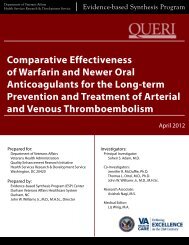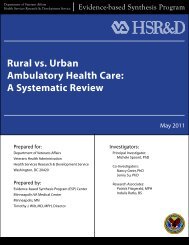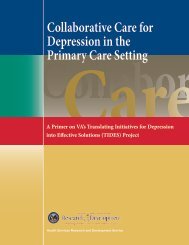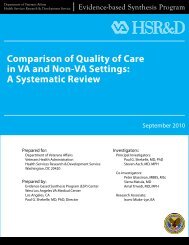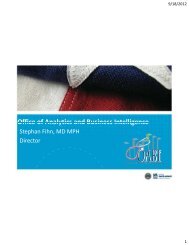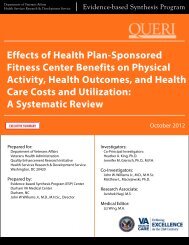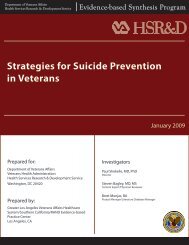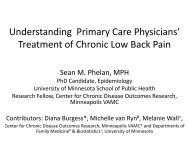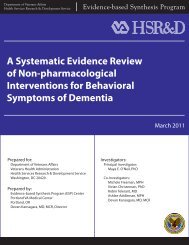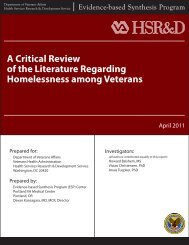Comparative Effectiveness of New Oral Anticoagulants for ...
Comparative Effectiveness of New Oral Anticoagulants for ...
Comparative Effectiveness of New Oral Anticoagulants for ...
Create successful ePaper yourself
Turn your PDF publications into a flip-book with our unique Google optimized e-Paper software.
<strong>Comparative</strong> <strong>Effectiveness</strong> <strong>of</strong> <strong>New</strong> <strong>Oral</strong> <strong>Anticoagulants</strong><br />
<strong>for</strong> Thromboprophylaxis<br />
Evidence-based Synthesis Program<br />
CLINICAL AND POLICY IMPLICATIONS<br />
Patients undergoing total knee replacement or total hip replacement are at a significant<br />
risk <strong>for</strong> VTE. The precise risk <strong>for</strong> VTE in contemporary orthopedic surgery is difficult to<br />
estimate because <strong>of</strong> changes in surgical management, the paucity <strong>of</strong> recent trials comparing<br />
thromboprophylaxis to placebo, and the high frequency <strong>of</strong> thromboprophylaxis in routine<br />
practice, making observational studies <strong>of</strong> natural history difficult to conduct. A recent,<br />
careful analysis estimated the prevalence <strong>of</strong> symptomatic VTE without thromboprophylaxis<br />
at 2.8 percent <strong>for</strong> the initial 14 days and 4.3 percent at 35 days following major orthopedic<br />
surgery. 1 Appropriate use <strong>of</strong> perioperative thromboprophylaxis significantly reduces the risk <strong>of</strong><br />
postoperative proximal VTE, but the evidence is much more limited <strong>for</strong> effects on symptomatic<br />
DVT, PE, and mortality. 1,9<br />
Our evidence synthesis primarily addresses the comparative effectiveness <strong>of</strong> newer oral<br />
anticoagulants compared with standard antithrombotic agents <strong>for</strong> VTE prophylaxis. These newer<br />
drugs have been compared only to LMWH and show similar effects on most major clinical<br />
outcomes, although the strength <strong>of</strong> evidence varies by drug class and specific drug. In evaluating<br />
whether to add these newer agents to the VA <strong>for</strong>mulary and whether to promote a specific<br />
thromboprophylaxis strategy, consideration should be given to the evidence <strong>of</strong> effectiveness<br />
and the importance and variability <strong>of</strong> patient values and preferences, costs, and health care<br />
system resources <strong>for</strong> successfully implementing competing strategies. In the following section,<br />
we summarize recommendations from the two major U.S. clinical guideline panels that have<br />
addressed this issue.<br />
Guidelines<br />
Both the American College <strong>of</strong> Chest Physicians (ACCP) and the American Academy <strong>of</strong><br />
Orthopaedic Surgeons (AAOS) have recently issued guidelines on thromboprophylaxis in<br />
patients undergoing TKR or THR. 1,2,24 The ACCP recommends antithrombotic prophylaxis over<br />
no prophylaxis <strong>for</strong> patients undergoing TKR or THR. The AAOS guidelines suggest individual<br />
assessment <strong>of</strong> patients <strong>for</strong> thromboprophylaxis. For patients at average risk, the guidelines do<br />
not include a recommendation <strong>for</strong> a specific thromboprophylactic strategy, considering the<br />
evidence <strong>for</strong> comparative effectiveness to be inconclusive. In contrast, the ACCP guidelines make<br />
recommendations <strong>for</strong> specific strategies and include the following options: LMWH, fondaparinux,<br />
apixaban, dabigatran, rivaroxaban, low-dose unfractionated heparin, adjusted-dose vitamin K<br />
antagonists, aspirin, or an intermittent pneumatic compression device. However, in the absence <strong>of</strong><br />
elevated bleeding risk, LMWH is recommended in preference to other agents. Factors identified as<br />
increasing the risk <strong>of</strong> bleeding include previous major bleeding, severe renal failure, concomitant<br />
antiplatelet use, and a history <strong>of</strong> or difficult-to-control surgical bleeding during the current operative<br />
procedure, extensive surgical dissection, and revision surgery. 1 For patients with increased bleeding<br />
risk, ACCP recommends intermittent pneumatic compression device or no prophylaxis.<br />
In making recommendations, both guideline panels considered benefits and potential harms but<br />
had different approaches to considering costs. The AAOS did not conduct cost analyses and<br />
instructed guideline members to consider costs only when the impact was likely to be substantial.<br />
The ACCP process considered costs when it was plausible that resource use might change<br />
34




